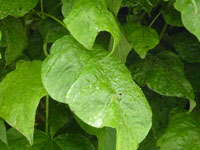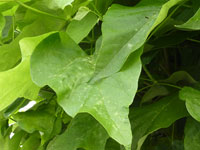Experiences with Aphids

Petroleum C 30: Homeopathic Treatment of White Hairy Lice on Catalpa |
 |  |
| 22. Juni | 14. Juli |
On June 22nd the tree was treated with Petroleum 30 C (6 pellets in 20 litres of water), poured onto the roots, and the oily drops subsequently disappeared. But then an even stronger glistening, sticky honey-like film appeared on the leaves and the ground beneath the tree. Seven days after Petroleum 30 C, we applied the same dose of Sulphur 200 C (twice, at an interval of five days). Some leaves fell off since they had died due to the sucking action; but the lice only slowly diminished in number. On July 9th 2015 Maute-Rundum 30 C was applied by watering the tree with a solution of 8 pellets in 30 litres of water. The lice then rapidly declined, and had completely disappeared by July 14th (picture 2).
Cornelia Maute 2015
Petroleum – black aphids and red spider mites on hibiscus pot plants
"Now I'd like to tell you about my 'successes', which leave me rather 'speechless' but in a nice way! I've got a series of large hibiscus pot plants. Every year when I bring them back into the house, they quickly come down with aphids. Then I give the plants 'poison capsules'. One dose keeps the plants free of aphids the whole winter. So that's what I've been doing with success (though not with a clear conscience!!!) for years now. This year everything was different: one plant was covered in black aphids (buds and flowers), and the aphids were not repelled even by repeat doses of the poison capsules. They were constantly reproducing but thankfully did not attack the neighbouring plants. When I got my homeopathic remedies, I put a few pellets of Cimicifuga 30 C in a sprayer, shook it, and sprayed my hibiscus. The next day I could scarcely believe my eyes – the aphids were gone. I sprayed a second hibiscus suffering infestation with red spider mites. Nothing happened! Then I sprayed it with Petroleum 30 C – all the spiders and their webs were gone!!!!! I can scarcely believe it!!! I just did not reckon it would work so quickly!! Unfortunately I didn't take any pictures – as evidence!!! Now I really hope that Helix tosta does the job for slugs – which will certainly be out in force after the mild winter!"
Mechthild K., Austria 2013
 Aphidius (ichneumon fly)
Aphidius (ichneumon fly)
Aphidius 6D : Lice
Small fruit trees in container were raised in the house on the window sill. The leaves were infested with lice and watered once with Aphidius. After a few days, the lice disappeared.
The small damson tree remained lice-free. The lice returned to the small cherry tree after a while.
![]() » Aphidius (ichneumon fly) order
» Aphidius (ichneumon fly) order
 Chrysoperla carnea (green lacewing larva)
Chrysoperla carnea (green lacewing larva)
Coccinella and Chrysoperla 6D:
Green aphids on the tips of the rose shoots: Coccinella 6 was sprayed and after about 3 days there were no more aphids to be seen. Unfortunately they reappeared and a further spraying with Coccinella did not help. Then I sprayed with Chrysoperla carnea and the aphids were gone – so far (approx 3 months), they haven't returned on the roses I treated.
![]() » Chrysoperla carnea (green lacewing larva) order
» Chrysoperla carnea (green lacewing larva) order
 Cimicifuga
Cimicifuga
Cimicifuga – black aphids and red spider mites on hibiscus pot plants"Now I'd like to tell you about my 'successes', which leave me rather 'speechless' but in a nice way! I've got a series of large hibiscus pot plants. Every year when I bring them back into the house, they quickly come down with aphids. Then I give the plants 'poison capsules'. One dose keeps the plants free of aphids the whole winter. So that's what I've been doing with success (though not with a clear conscience!!!) for years now. This year everything was different: one plant was covered in black aphids (buds and flowers), and the aphids were not repelled even by repeat doses of the poison capsules. They were constantly reproducing but thankfully did not attack the neighbouring plants. When I got my homeopathic remedies, I put a few pellets of Cimicifuga 30 C in a sprayer, shook it, and sprayed my hibiscus. The next day I could scarcely believe my eyes – the aphids were gone. I sprayed a second hibiscus suffering infestation with red spider mites. Nothing happened! Then I sprayed it with Petroleum 30 C – all the spiders and their webs were gone!!!!! I can scarcely believe it!!! I just did not reckon it would work so quickly!! Unfortunately I didn't take any pictures – as evidence!!! Now I really hope that Helix tosta does the job for slugs – which will certainly be out in force after the mild winter!"
Mechthild K., Austria 2013
 Coccinella sept. (ladybird)
Coccinella sept. (ladybird)
Homeopathic Treatment for Aphids on Cucumbers
We had severe aphid infestation on our cucumbers. Following the recommendation of V. D. Kaviraj, we watered these and all other plants at an interval of one week with liquid Coccinella 6 D. There were fewer insects afterwards.
Around 2 weeks later we repeated the application. The infestation, also on our roses, has not appeared again since then. Great!
Markus J., Cologne, Germany, June 2015
Coccinella D6: Green aphids on roses, sprayed 1x with the sprayer, the rest were watered on the roots. After approx 1 week, the aphids had disappeared.
Coccinella D6: Green aphids on the tips of rose shoots, 3x sprayed with diminishing dosage on the days indicated by the planting calendar. Aphids diminished and had disappeared after 14 days.
Coccinella D6: Black aphids on blackberry, roses, and cucumbers were watered and sprayed on 3 successive days. After 3 further days, there were no more aphids to be seen.
D6: Rose mallow indoors with aphid (green) infestation was watered once with Coccinella 6D (3 pellets in 10 liters water). No significant improvement in the aphids could be seen (maybe it would have helped to water several times – although Kaviraj advises against this). (SB)
30C: Black aphids on guelder rose. 3 pellets in 10 liters watered once to combat black aphids on guelder rose – after two weeks, there were no more aphids to be seen. (SB)
200C: Aphids on roses. Watering of the plants. All aphids had disappeared within 2-3 days. I only had to spray again 3 months later, and then it was just as successful as the first time. (GP)
![]() » Coccinella sept. (ladybird) order
» Coccinella sept. (ladybird) order
 Cuprum metallicum
Cuprum metallicum
Homeopathic treatment of aphids and black spot on roses
 For
the last two years I have used no chemicals in my garden and treated
all pests and fungal infections with homeopathic remedies. My
impression in the second year is that the plants are generally stronger
and more healthy so they do not immediately fall prey to aphids and
caterpillars. The roses only needed a single treatment in spring,
following which the aphids were gone for the whole year. The same was
true for black spot.
For
the last two years I have used no chemicals in my garden and treated
all pests and fungal infections with homeopathic remedies. My
impression in the second year is that the plants are generally stronger
and more healthy so they do not immediately fall prey to aphids and
caterpillars. The roses only needed a single treatment in spring,
following which the aphids were gone for the whole year. The same was
true for black spot.
To reduce the effort required to treat the plants throughout summer, I filled large (approx 500 ml) screw-top jars with water and 10 pellets of each remedy. I stored the jars in a cool, shady place. Then I stirred the mixture vigorously when required, and poured one third into a watering can (7 litres) or a large sprayer, once more stirring it vigorously, and then using it immediately. The plants were either watered or sprayed until they were dripping wet, with the remainder added to the root area.
Last year I treated the roses for green aphids using Cimicifuga 30C, as recommended by Christiane Maute. But this was not especially successful. When the black spot reappeared, I applied Rhus tox 30C
(Christiane Maute says this is especially good for roses), which
worked well. The new shoots were healthy, unlike the previous new
growth. Since the summer was quite humid, I had to repeat the treatment
after a while. This year I treated all green aphid infestations with Cuprum 30C
(for insect infestation and pests in general), which quickly proved
successful. All plants, whether rose, hibiscus or currants, were
treated for green aphid infestation with Cuprum and for black aphid infestation with Camphora 30C.
I did not differentiate by plant but by pest. Note
that my plants were given fresh earth and compost in spring, and the
roses received slow-acting fertilizer. They are not weak and are
watered sufficiently. This influences the remedy choice. When black
spot appeared anyway, I used Rhus tox
again (just once). I did nothing more after the treatment in spring.
The roses remained free of aphids and the black spot only appeared on
one or two leaves, which I plucked off.
 Another thing I noticed was that, when the hot period
was followed by cooler weather with rain, the roses revived, with new
shoots and buds appearing. I have never had such beautiful roses in
autumn. But the very hot weather is less likely to have encouraged
fungal growth on the roses, as occurred in the wet summer of 2014.
Another thing I noticed was that, when the hot period
was followed by cooler weather with rain, the roses revived, with new
shoots and buds appearing. I have never had such beautiful roses in
autumn. But the very hot weather is less likely to have encouraged
fungal growth on the roses, as occurred in the wet summer of 2014.

Pictures taken on 29th September 2015
 Ledum
Ledum
Ledum 6D: Aphids: Brief report on my (first) experience of treating plants with homeopathy: strong and repeated aphid infestation (mostly green ones, a few black ones, too) on a rue. The use of beneficial insects as pest control was not successful in the long term. 3 pellets Ledum 6D dissolved in ca. 300 ml water, watering of the plant in small amounts over a period of several days. The first few days more frequent, then in reducing frequency. After about 1 week, no more aphids to be seen – this has been the case for 4 weeks now.
 Staphisagria
Staphisagria
Staphisagria 200: Black Aphids on Elderberry
In Ms O's garden there is a very big elderberry bush, which was visibly afflicted in June this year by countless black aphids. So Ms O. began treating the bush by spraying it with Cimicifuga 30 C (6 pellets in 10 liters of water), according to the recommendation from Christiane Maute, repeated for three days. She observed that the number of aphids declined from day to day. On the fourth day, she continued treatment with three doses of Staphisagria 200 C, which is also indicated for aphids. After two weeks, the elderberry bush was completely free of aphids.
Ute O. , Achern, Germany, 2013
Staphisagria
200 C: Black aphids, Clematis,
planted in spring; Slight infestation with black aphids (protected by ants).Treated on June 25 with Staphisagria 200 C.
Barbara W.

 Tropaeolum (nasturtium)
Tropaeolum (nasturtium)
Tropaeolum 6D: In a 30-year-old Swiss pine, with severe mealy bugs, a single spraying and a single watering with Tropaeolum 6D (5 ml /10 liters water) brought excellent results (after approx 1 week).






